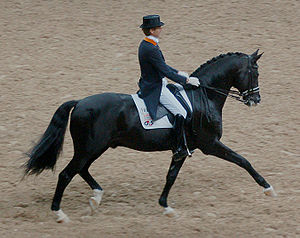|

A Trakehner performing dressage
...Warmbloods are a group of middle-weight horse types and breeds, primarily originating in Europe, registered with organizations that are characterized by open studbook policy, studbook selection, and the aim of breeding for equestrian sport. The term distinguishes these horses from both heavy draft horses ("cold bloods") and refined light saddle horses such as the Thoroughbred and Arabian ("hot bloods"). Though modern Warmbloods are descended from heavier agricultural types systematically upgraded by hotblood influence, the term does not imply that Warmbloods are direct crosses of "cold" and "hot." It is thought that the Warmblood type, which originated in continental Europe, descended from a landrace of wild, native proto-warmblood ancestors, and possibly trace back to a wild prototype called the Forest Horse.
Breeding Policies
Open studbook policies separate most warmbloods from true "breeds" such as Thoroughbreds, Arabians, Percherons, Morgans, which have a closed stud book and require two purebred parents. Instead, most warmblood registries accept breeding stock from other similar populations to continuously improve their own horses, and do not consider their own horses to be a discrete "breed." The Trakehner is an exception, so though some other breeds are used within the breeding population, this horse is considered a true breed. The Hanoverian, Holsteiner, and Selle Francais studbooks are also considered slightly less open than others. Most warmblood registries recognize breeding stock from any other registry that is a member of the World Breeding Federation for Sport Horses, which is affiliated with the IOC-recognized International Federation for Equestrian Sports.
A defining characteristic of a Warmblood registry is studbook selection, though even some purebred breeds in Europe use this practice. Studbook selection is the use of external evaluation - critiquing conformation and movement - of potential breeding stock to cull out unsuitable breeding horses and direct the evolution towards a particular goal. Today, studbook selection usually entails a performance proof in addition to external evaluation, particularly for stallions.
Standards of conformation and movement are not designed to perpetuate a particular ancestral type, but rather to meet a particular need. This concept is illustrated by the history of the Oldenburg horse through the past 150 years: in the late 1800s, the standard called for a heavy but elegant, high-stepping carriage horse, in the early 1900s for a heavier, stronger, economical farm and artillery horse, and since 1950 for a modern sport horse.
The most critical characteristic of a Warmblood registry is that its breeding goal or "breeding aim" is to breed sport horses. Each registry has a slightly different focus, but most breed primarily for show jumping and dressage, though many include combined driving and eventing as well. The breeding aim is reflective of the needs of the market. In eras and regions which called for cavalry mounts, Warmbloods were bred to fit that need; when and where horses for light to moderate agricultural work were needed, Warmbloods have filled those roles, too. The purposeful evolution of the standard breeding aim is another characteristic of the Warmbloods.
Warmbloods have come into their own since the end of World War II, when mechanization made agricultural horses obsolete and recreational riding became more widespread in the western world. The ancestral types are referred to as the heavy warmbloods and are preserved through special organizations. The heavy warmbloods have found their niche as family horses and in combined driving.
Warmblood Horse Breeds
Most warmbloods were developed in continental Europe. Germany is particularly known for breeding warmbloods.
...The Heavy Warmbloods (German: Schwere Warmblüter) are a group of horse breeds primarily from continental Europe. The title includes the Alt-Oldenburg ("Old-Oldenburg"), Ostfriese ("East Friesian"), Groningen, and similar horses from Silesia, Saxony-Thuringia, and Bavaria. Breeds like the Hungarian Nonius, Kladruber, and Cleveland Bay are also often classed as "heavy warmbloods." They are the ancestors of the modern warmbloods, and are typically bred by preservation groups to fit the pre-World War model of the all-purpose utility horse. Unlike the registries of the sport horses that followed them, many heavy warmblood registries maintain closed or partly-closed studbooks. However, external evaluation and performance testing of the breeding stock is still a key element in these registries. Many of the heavy warmbloods are selected primarily for family-friendly temperaments...  Heavy Warmbloods Heavy Warmbloods
Several of these breeds are also represented by ancestral types such as the Ostfriesen and Alt-Oldenburger, Alt-Württemberger, and Rottaler.
Warmblood registries which are not based in continental Europe include those that regulate the breeding of American Warmbloods and Irish Sport Horses
For More Information:
World Breeding Federation of Sport Horses
International Museum of the Horse
What Is A Warmblood?
|